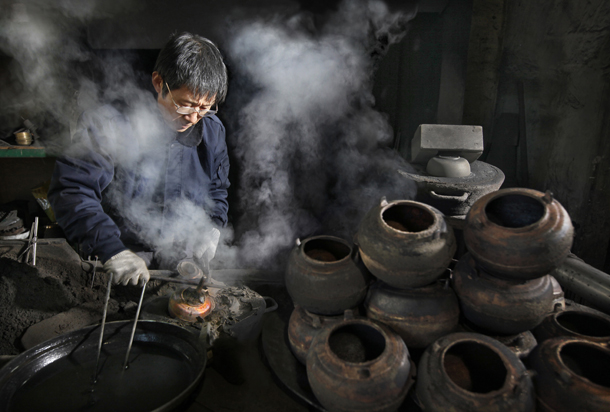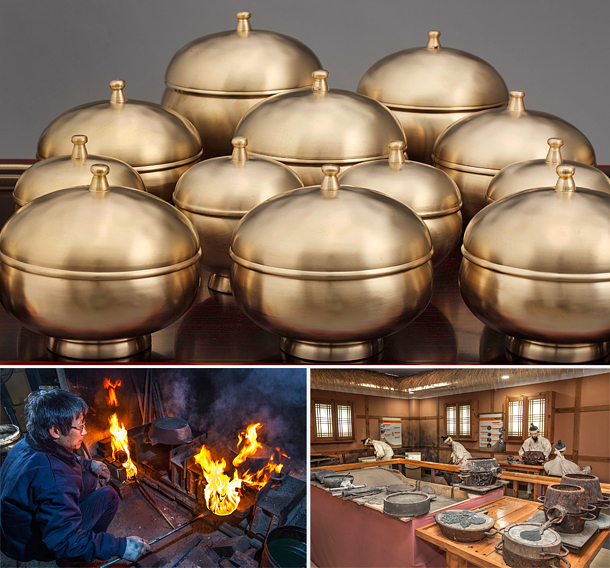Workshop maintains brassware tradition

Artisan Kim Soo-young produces brassware using a traditional method. Anseong’s brassware is commonly believed to be the best of its kind. [PARK SANG-MOON]
Despite the cold weather, Kim was shedding beads of sweat shaping his bowls, as he added that this is the busiest time of the year for brassware artisans. The tips of his fingers were fully concentrated on forming shiny gold dishes and bowls.
Although it’s not known for sure when Koreans began using brassware, it is believed to have started in the Bronze Age. During the Shilla Dynasty (57 B.C.-A.D. 935), an organization specialized in brassware making, called cheolyujeon, was established and this later led to high-quality brassware being exported to foreign nations in the Goryeo Dynasty (918-1392). The popularity of brassware products surged a bit during the early years of the Joseon Dynasty (1392-1910), but its use was soon widely distributed to the public in the 18th century. The art of creating brassware was designated National Intangible Heritage Cultural Heritage No. 77 in 1983.
The use of brassware was quite common until the 1950s, but with the advent of industrial development, items made of new materials like plastic, aluminum and stainless steel appeared. This eventually led to the decline of brassware. Not only that, brassware discolored easily when it met with smoke from coal briquettes. When briquettes began to be used widely, brassware was met with the possibility of disappearing for good.
Kim has contributed all his life to saving brassware from dying out. Kim’s father, Kim Keun-su (1916-2009), who was also a brassware artisan, established what stands as Anseong Machum Brassware Workshop right after Korea gained its independence from Japan, when brassware was at its peak. His son later took on the workshop and strived to protect it.

Top: Items produced at Anseong Machum Brassware Workshop. Bottom left: Kim Soo-young parches brassware with fire in order to smoothen its surface and make it easier for molten metal to be absorbed. Bottom right: Visitors may look through the history of brassware at Anseong Machum Brassware Museum.
There are two kinds of brassware in Anseong. One is made in large quantities to be sold at the market, while the other is customized. Most households bought their bowls at markets, but wealthy families ordered the items directly from workshops. This is where the Korean term “anseong machum,” which means “just the right thing,” comes from.
At Anseong Machum Brassware Workshop, workers produce brassware using two different methods - bangjja and jumul. Anseong’s bangjja brassware, made with precisely 78 percent copper and 22 percent tin, is made by heating lumps of brass and beating them with tools like hammers. This type of brassware is fairly strong and does not bend or break easily. Hence most cutlery is produced using the bangjja method.
Items made through the jumul method are quite small compared to the former. This method is also well-suited for produce that requires more detail. Jumul brassware is made by melting copper and tin together and pouring it into the cast all at once. Since jumul brassware can touch fire, items like kettles, braziers and hot pots are commonly produced through this method.
In addition to carrying on the legacy of brassware making, Kim is also putting effort into developing items that suit modern day people. Not only that, people now have a higher standard of living and strive to bring traditional culture into their lives, which adds to the rising popularity of brassware. In other words, brassware is slowly regaining its reputation as its beauty and remarkable thermal and antibacterial functions are catching more and more people’s eyes.
Other than bowls, Kim also produces ornaments like candlesticks and bells. He is taking part in more elaborate works like reproducing relics for museums and restoring utensils used in the Jongmyo Shrine. Although it requires more time and effort, Kim is sticking to manual handwork in order to make high-quality products. He also opened the Anseong Machum Brassware Museum in 2012 to widely distribute and pass down this precious legacy.
Producing brassware requires great work, but Kim can always be spotted in his workshop with his fellow workers. As he engraves his name on each of his productions, Kim is determined to produce brassware that could be used and passed down to multiple generations. He is also thankful that his sons are engaged in inheriting the work. With all of the hard work going on at Anseong Machum Brassware Museum, brassware may soon evolve into a more glorious tradition in the future.
BY PARK SANG-MOON [moonpark@joongang.co.kr]










with the Korea JoongAng Daily
To write comments, please log in to one of the accounts.
Standards Board Policy (0/250자)